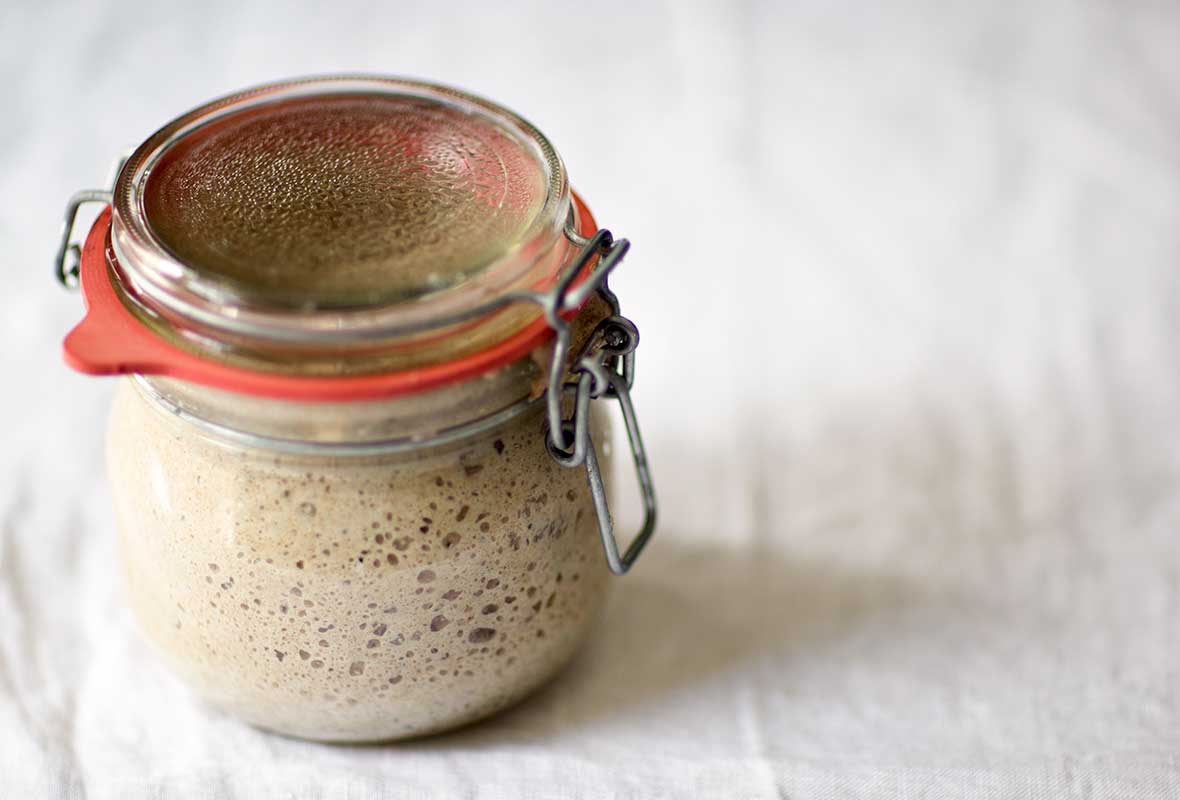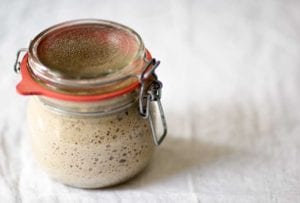
It’s not hard to make a rye sourdough starter from scratch. Some sourdough starters rely on wild yeasts that live in the air, others on acid-producing bacteria present in buttermilk, yogurt, pineapple juice, and the like, and still others start with commercial yeast or store-bought starters. Fact is, none of these additives is necessary. All it really takes to build a delicious and robust rye sour culture, or starter, is some whole-grain rye flour, water, a warm place, and patience. [Editor’s Note: And when your traditional rye sourdough starter is complete, the very first thing you’re going to want to do is use it to make this Galician rye bread.]–Stanley Ginsberg
☞ LEARN MORE, READ: HOW TO DRY SOURDOUGH STARTER

Rye Sourdough Starter
Ingredients
Day 1: Make the Rye Sourdough Starter
- 2.5 ounces whole grain rye flour, preferably organic
- 2.5 ounces warm water (105°F or 41°C)
Days 2 to 7: Refresh the Rye Sourdough Starter
- 2.5 ounces whole grain rye flour, preferably organic
- 2.5 ounces warm water (105°F or 41°C)
- 2.5 ounces Sour Starter from the preceding day
Days 8 and Beyond: Maintain the Rye Sourdough Starter
- 2.5 ounces medium or whole-grain rye flour, preferably organic
- 2.5 ounces warm water (105°F or 41°C)
- .25 ounces rye sourdough starter
Instructions
Day 1: Make the rye sourdough starter
- Start with equal amounts of organic rye flour and water by weight. Dump them in a nonreactive (glass, porcelain, stainless-steel, plastic) container, mix by hand into a stiff paste, cover, and let stand at room temperature (68 to 72°F or 20 to 22°C) for 24 hours.
☞ TESTER TIP: Occasionally the yeast normally present in whole grains fail to establish itself in a new culture; if, after 3 or 4 days, the culture darkens, develops a mold, or smells bad, dump the whole batch and start over. After a week, the culture, or sourdough starter, will be ready to use or to be stored refrigerated in an airtight container for a couple days. [Editor's Note: If storing the sourdough starter for more than a couple days, you'll need to maintain it, which we explain how to do just below.]
Days 2 to 7: Refresh the rye sourdough starter
- The next day, discard all but 2 1/2 ounces (70 grams) of the culture and mix the remainder with the refresh ingredients, cover, and let stand. Repeat each day, discarding all but 2 1/2 ounces (70 grams) of the preceding day’s culture.
☞ TESTER TIP: The most important point to remember at the early stages is to feed the sourdough starter daily. Even when it shows no apparent fermentation, the yeast is busy multiplying and consuming nutrients at a very high rate. By the second or third day, it will swell, show bubbles, and give off a clean sour smell. Over the next few days the activity will become more and more vigorous and the smell more intense.
Days 8 and Beyond: Maintain the rye sourdough starter
- In a perfect world—or in a working bakery—sourdough starters are refreshed daily. That said, daily feedings demand both a degree of dedication and abundant flour supplies that are impractical for all but the most committed home bakers. You can get by refreshing your starter every 36 hours or so.
- Mix the rye flour, water, and rye sourdough starter by hand until incorporated. Cover and ferment at room temperature (68 to 72°F or 20 to 22°C) overnight or for 10 to 12 hours. The sponge will be very bubbly, have a clean sour smell, and will have tripled in volume. Store refrigerated in an airtight container and it will last indefinitely.

Nutrition
Nutrition information is automatically calculated, so should only be used as an approximation.
Recipe Testers’ Reviews
The rye starter was easy to make and quick. It took about 5 minutes each of the 7 days. Mine smelled great and seemed consistent after the week of feedings. I switched to the refresh amounts after that and it stayed nice and healthy.
During the buildup, you end up tossing about 2/3 of it away. I definitely recommend a scale versus just using volume measurements.










Hello. The short steps require mixing 75 g water, 75 g rye flour and 75 g starter from previous day between days 1-7. But the longer explanation states that 75 g starter from previous day should be discarted and 75 g water and 75 g flour should be added to remaining starter. Which of these is the correct procedure?
Niya, can you please clarify where you’re seeing two different sets of directions? I only see the direction to discard everything except 70g of starter, which gets mixed with the flour and water.
Oh, now I realize how I wasn’t careful about the part “all but..” :)))) Sincere appologies!
“The next day, discard all but 70 grams of the culture and mix the remainder with the refresh ingredients, cover, and let stand.”
Not a problem, Niya. Glad we got it sorted out!
My rye starter is doing very little. only a few tiny bubbles on day 4. My kitchen averages 67 degrees in 24 hours. I used rye flour that had been on my shelf for years. Can old flour lose its ability to become active starter?
Barbara, 67° is a bit cool. I try to keep mine around 75°F. And it’s been my experience that old flour doesn’t react the same way as fresh. Plus, rye flour can go rancid. Recently, I had the same issue with my new rye sourdough starter. I bought freshly milled flour, and it exploded! Exploded, in a good way.
Hello. The recipe asks for 2.5 oz starter up to day 7, then only 0.25 thereon. Is this correct or is it a typo? Thanks!
Days 2 to 7: Refresh the Rye Sourdough Starter
▢ 2.5 ounces whole-grain rye flour preferably organic
▢ 2.5 ounces warm water (105°F or 41°C)
▢ 2.5 ounces Sour Starter from the preceding day
Days 8 and Beyond: Maintain the Rye Sourdough Starter
▢ 2.5 ounces medium or whole-grain rye flour preferably organic
▢ 2.5 ounces warm water (105°F or 41°C)
▢ .25 ounces rye sourdough starter
Thanks for checking, Robert. It is correct. Once you get your starter well established, that small amount of starter is all you need to keep it going and healthy.
Beautiful! Thank you Angie!
You’re welcome, Robert.
Is the .25 ratio correct for day 8 and beyond? It’s not a 2.5 typo?
Tiffany, I know it seems low, but it’s correct.
Thank you! I’m on day 8 now, does that mean I toss everything except .25 ounces starter, feed as usual, then that is what I keep in the fridge and refresh weekly with the same .25 starter/2.5 oz rye/2.5 oz water? Thanks!
Yes, Tiffany, exactly. I would make sure that your starter is well established and at least doubling after feeding before going to a weekly schedule, though.
Thank you Angie! My starter is definitely bubbling, but it hasn’t doubled within the 24 hr feeds yet. I left it longer this time (48 hrs) and I dare say it has mold on it now – is this possible or have I ruined the batch? Also, does rye take longer to grow? I’ve been meticulously measuring each feeding, and get a pretty thick paste every time, nothing is ever runny or even close to it. I appreciate your insight!
Tiffany, mold on a sourdough starter is pretty rare. It’s usually caused by contamination (food, a dirty spoon, soap, etc.) or weak yeast due to a missed feeding. Take heart, though: It took me quite a while to get my sourdough starter working–I’m talking weeks and weeks. I had many failed attempts.
Considering the amount of mold, I’d start again.
But if you want to try to revive this batch, follow these instructions. They’re from Cultures for Health.
Instructions for Recovering a Moldy Sourdough Starter:
1. Remove the mold from the surface.
2. Using a clean utensil, remove a small portion of the sourdough that wasn’t near the mold. A tablespoon will suffice.
3. Put that tablespoon in a clean container, and feed using the ratio of one part starter to one part water to a scant two parts flour. If measuring ingredients by weight, use equal parts of starter, flour, and water.
4. Mix, cover with a breathable lid, and proof for 12 hours.
5. Feed the sourdough starter again using the same ratio. Continue to feed for several days and watch carefully for any signs of mold.
6. If there are no signs of mold or unpleasant aroma, the starter may be used again for baking or stored in the refrigerator.